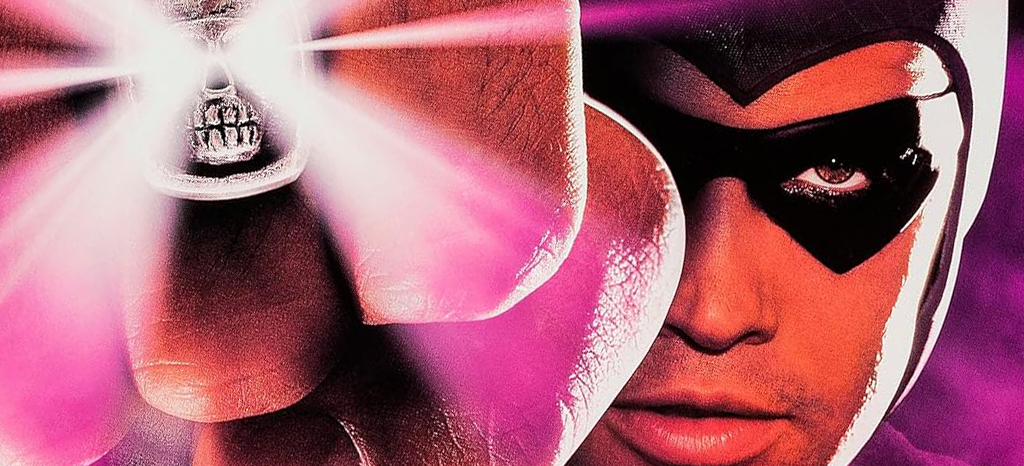
Everybody knows the ups and downs of superhero cinema over the decades. Christopher Reeve made us believe a man could fly in 1978, and Tim Burton shook off the campy legacy of Adam West with Batman ‘89. Marvel crawled out of bankruptcy to take Hollywood by storm with the likes of Blade (1998), X-Men (2000) and Spider-Man (2002), only to change the course of superhero cinema forever with Iron Man in 2008. And let’s not forget how Batman Begins (2005) and The Dark Knight (2008) proved that superhero movies could be mature pieces of cinema, setting the tone for superhero media for years to come.
However, countless underappreciated gems have fallen through the gaps between these pop-cultural touchstones. Movies that may have been ahead of their time, or simply weren’t a popular enough property to garner audience interest. Movies that, if given a second look, might have more to offer than people give them credit for. Movies like 1996’s The Phantom, a fun, thrilling action-adventure film starring Supa-Star Billy Zane as one of the world’s first costumed heroes.
Ahead of his appearances at Supanova in Sydney (21-22 June) and Perth (28-29 June), let’s talk about how Zane brought the Ghost Who Walks to life.
The Phantom character debuted in newspapers around the world in February, 1936, created by Lee Falk and initially drawn by Ray Moore. That’s right kids, before comic books were a thing, newspapers published comic strips – think of it as a comic book adventure published three panels at a time and spread out across a year’s worth of newspapers. The Phantom debuted a good two years before Superman hit the newsstands, at a time when adventure strips and pulp action heroes were all the rage. As such, The Phantom serves as something of a missing link between those pulp action/adventure heroes, and the costumed superheroes who were waiting just over the horizon.
 His origin was laid out early on and has remained essentially untouched ever since: Over 400 (now 500) years ago, a merchant ship was attacked by pirates off the coast of Africa. The merchant captain’s son saw his father killed by the pirates, before falling overboard. After washing ashore, the young man was nursed to health by the local people and later made an oath on the skull of his father’s murderer, committing himself and his descendants to a never-ending fight against piracy, cruelty, greed and injustice.
His origin was laid out early on and has remained essentially untouched ever since: Over 400 (now 500) years ago, a merchant ship was attacked by pirates off the coast of Africa. The merchant captain’s son saw his father killed by the pirates, before falling overboard. After washing ashore, the young man was nursed to health by the local people and later made an oath on the skull of his father’s murderer, committing himself and his descendants to a never-ending fight against piracy, cruelty, greed and injustice.
Over the centuries, though, the world believed this succession of costumed heroes to be the same man: A Ghost Who Walks. The Phantom’s roots lie in the pulp heroes of the time, like the Spider, and jungle adventure stories like Tarzan, but Falk introduced new concepts which would help his character stand out, while laying the building blocks for the burgeoning superhero genre. Most notably, this included the decision to dress the jungle-dwelling character in tights and a domino mask (including the now iconic white eyes), which would become standard attire for the superheroes of the next decade.
Falk even toyed with the idea of giving The Phantom the secret identity of a wealthy New York socialite, years before Bruce Wayne was a twinkle in Bill Finger’s eye. If he hadn’t opted to keep him living in his jungle Skull Cave instead, who knows how the course of Batman’s creation may have been altered? This is all to say that The Phantom truly is the progenitor of the superhero genre as we know it, even if he doesn’t often get his due.
Fast-forward sixty years, though, and it was finally time for The Phantom to burst onto the big screen, with a big-budget feature film directed by Australia’s own Simon Wincer. Cast in the leading role was the legendary Billy Zane, who was best known at the time for films such as Dead Calm (1989), Demon Knight (1995) and Back to the Future (1985). Keep in mind, this was seven years after Tim Burton’s Batman and two years before Blade. Superhero films were in a bit of a slump.
Yet, Zane took the role incredibly seriously, forgoing a padded suit and instead working out for over a year in order to put on the muscle necessary to portray the character. You never once doubt that Zane’s Phantom was born and raised in the jungle, leaping onto planes and cars with a believable degree of effort. After growing so accustomed to heroes in CGI nanotech suits that glow with random highlights, it’s a nice change to see a regular, albeit well-built, man just leaping into the fray. He’s not perfectly trained; he gets hit or stabbed sometimes, but he always comes out on top. Most importantly, Zane has you believing every minute of it.
Just as important as the physicality, though, Zane really managed to capture The Phantom’s charm and wry sense of humour that always helped him stand out on the page. Zane just oozes that movie star charm of a bygone age, whether in the purple tights or in a dashing three-piece suit when in civilian mode as Kit Walker. There’s something to his smile that just instantly reassures you that when he says he’s a friend, he means it. Yet a dip of the eyes and a lowered head instantly conveys the pathos of a character weighed down by centuries of familial duty and the filial responsibility to avenge his slain father. It’s practically Shakespearean, right down to the skull imagery.
Despite its slightly campy, swashbuckling nature, The Phantom has some strong themes running through it, and Zane carries them into his performance without ever breaking the film’s tone. Despite harkening back to a simpler time, The Phantom, as presented here, is a fully-rounded character with clearly-defined motivations and a distinctively personal character arc. Treading the line between classic and bland is a difficult task, but Zane pulls it off flawlessly.
Speaking of the film’s tone, though, this is the type of movie we just don’t see anymore, which is a darn shame. Is it a little silly? Maybe. But you know what else it is? Fun, and with a distinctive charisma to it. Much like the Indiana Jones films before it, it feels like an old film serial was transplanted in time and given a contemporary paint job. We get jungle heroics, the allure of 1930s New York, an entertainingly over-the-top villain and a spirited heroine who’s every bit as tough and capable as the leading man.
Black Widow is cool and all, but Diana Palmer will hit you with a right hook rather than tie you up, and she’s played by the original recipe Buffy to boot. You know what else she does? She rejects The Phantom’s implied marriage proposal to go and lead her own life, intending to return to him one day on her own terms. How unexpected is that for a movie made in 1996 and set in 1938? Seriously, why is Diana Palmer not a feminist icon?
Back to the original point, though. In an age when superhero movies sometimes feel like the actors recorded their lines on different days in front of a green screen, it can be refreshing to just enjoy some old-school action-adventure where things feel, maybe not real, but tactile at least. It’s the kind of quality stuff we need more of in modern cinema, and that’s said without an ounce of sarcasm.
There’s no denying that The Phantom is a very different beast from the superhero films we’ve become accustomed to over the past twenty-odd years. It’s even quite different to its contemporaries (we weren’t subjected to an avalanche of ice puns, after all), but that’s what makes it such a fun watch. It’s a refreshing change of pace and a snapshot from a bygone era, which was itself trying to pay homage to another bygone era.
It’s full of daring exploits and charming characters, and the whole thing is handled with love and care for the source material. So, the next time you’re feeling overwhelmed by the sheer volume of superhero content out there, why not pop The Phantom on and settle in for a rollicking, old-fashioned adventure instead?
Catch Billy Zane at Supanova in Sydney (21-22 June) and Perth (28-29 June).









